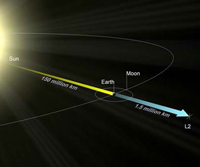Orbit / Navigation
Introduction
For JWST to be able to make precise infrared observations it is necessary that the telescope and its instruments are cooled. This ensures that they emit no infrared radiation of their own that would interfere with the signals from observed astronomical objects. This requirement is one of the reasons why JWST's orbit will be far away from Earth because sunlight reflected from the Earth's clouds and oceans creates enough heat to disturb the observations.
 |
|
An L2 orbit provides a benign and stable environment. Credit: ESA |
A special point in space, 1.5 million kilometres from Earth, is particularly stable and favourable for spacecraft. It is called L2, or the second Earth-Sun Lagrange point, and this is where JWST will be 'parked'. More precisely, it will move in a small 'halo' orbit around the L2 point.
The distance of the L2 point corresponds to about four times the distance from the Earth to the Moon, and is located on the opposite side of the Earth with respect to the Sun. (There is another stable point, L1, between the Earth and the Sun from where ESA's SOHO spacecraft observes the Sun.)
The remote location of JWST at L2 puts strict limits on its physical specifications. To be able to fly all the way to L2, JWST is restricted to around 6200 kilograms in mass, and it will need powerful radio transmission equipment to 'beam' back data to Earth.
What is L2?
More about the second Earth-Sun Lagrange point
An L2 orbit is an elliptical orbit about the second Lagrange point. A Lagrange point is, mathematically speaking, one of five solutions to the so-called three-body problem, in which three bodies will move as a stable configuration. The solutions were found by the brilliant Italian-French mathematician Joseph-Louis Lagrange (1736-1813).
Simply put, there are five special points in the vicinity of two objects orbiting around one another where a third, smaller mass can remain nearly 'parked' in orbit. Here it will keep the same distance from the two larger objects.
A physicist would, in technical terms, say that the Langrange points mark the positions where the gravitational pull of the two large masses precisely equals the centripetal force required to rotate with them.
In essence this means that at L2, the gravitation from the Sun and the Earth can keep a spacecraft rotating around the Sun in synchronisation with the Earth. This makes it a lot easier to, amongst other things, maintain communication with the spacecraft.
There are five Lagrange points in the Earth-Sun system: three in line with the Earth and the Sun and two points (L4 and L5) at the vertices of equilateral triangles where the Earth and Sun are at the other vertices.
Objects found orbiting around the L4 and L5 points in a system are called Trojans after the three large asteroids Agamemnon, Achilles and Hector that orbit in the Jupiter-Sun L4 and L5 points. (According to Homer's 'Iliad', Hector was the Trojan champion slain by Achilles during King Agamemnon's siege of Troy).
